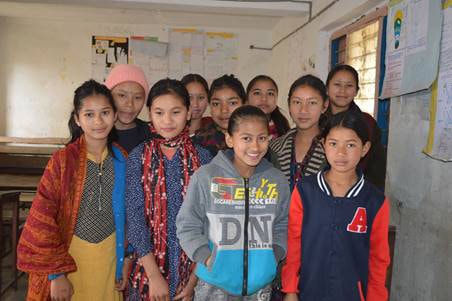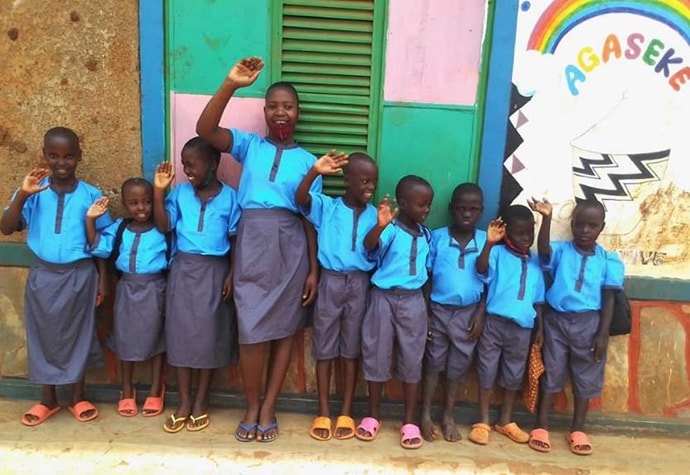Welcome to the April 2023 issue of the Global Washington newsletter.
IN THIS ISSUE
Letter from our Executive Director

Increases in gender equality in low- and middle-income countries can improve the pathways and support for quality education for girls. An increase in women in the workforce and leadership position provides powerful examples for the next generation and can spark a cultural shift to increase the value of girls’ education. It also provides the progression from education to jobs that is need for girls to stay within their communities and creates stronger societal cohesion.
This issue campaign on gender equality and education highlights Global Washington members working on gender equity to advance girls’ education. I hope you spend the time to read the articles and get to know the fantastic work of NGO members such as CARE and Worldreader, foundation members such as the Gates Foundation and Give2Asia, and for-profit GlobalWA members such as Microsoft and APCO.

Kristen Dailey
Executive Director
Back to Top
Issue Brief
Pioneering Solutions in Gender Equity and Education Access
By Aneesh Chatterjee
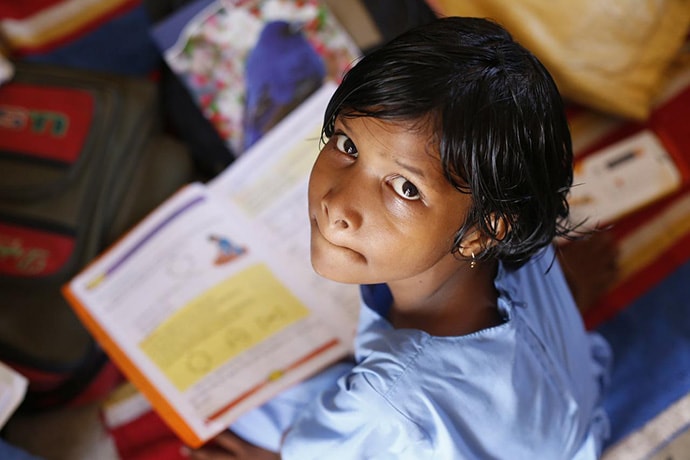
Young Indian schoolgirl. Photo: Pixabay
Gender equity and education, core tenets of SDGs 4 and 5, are issues with significant overlap. The Covid-19 pandemic has also exacerbated the issues these Goals seek to address. 147 million children have missed a significant portion of in-person learning, with 24 million students across multiple learning levels predicted never to return to schooling. Education access is also a core target for programs that address gender disparities, alongside the inclusion of women in political advocacy and leadership, and reducing gender-based violence.
The following GlobalWA members work to address matters of education access and improve gender disparities with solutions to unique challenges. These are but a few of the strategies employed by our members to address education needs and gender disparities. Also read in this issue about Rachel Hartgen, Senior Director, Education and Adolescent Empowerment, Program Strategy & Impact at CARE , as well as how Sahar Education has evolved and adapted their programs in response to the Taliban restrictions on girls’ and women’s education, and how Pygmy Survival Alliance has empowered and transformed their community through programs that teach women and children how to read.
Widespread structural change: Partnerships and training
The Bill & Melinda Gates Foundation has worked extensively in the areas of gender equity and empowerment, aiming to dissolve socio-economic barriers to opportunities for women, promote and encourage women to be autonomous and participate in the economy, and inculcating the integration of gender-based considerations across all aspects of their programs. An example of this integration is the Gender Equality Toolbox, a guiding set of documents that disseminate the central principles of program development with a gender-based focus, and the flexibility of such ideas being deployable in versatile and idiosyncratic scenarios. While addressing gender equality in any given region requires a unique and informed approach, the Toolbox distills core principles flexible enough to guide organizations no matter the individualistic tenets of their target system and is one of several initiatives by the Foundation to tackle global challenges in gender equality.

Examples of systematic approaches by the Foundation are the Global Framework for Advancing Women’s Empowerment and the Conceptual Model for Women and Girls’ Empowerment, the latter being one of the products available in the Gender Equality Toolbox. Both are exemplar strategies for developing systems that address core gender issues in regard to finance, education, and health. The Global Framework approach, for example, has demonstrated through a multi-regression correlation study across 95 countries that the removal of barriers, reframed as enabling factors – i.e. delayed marriage, school enrolment, family planning resources, legal working rights, access to safe public spaces and the freedom to travel within and outside their country – directly correlate with greater engagement in the economy and prove the importance of removing barriers for women. Another study revealed that access to economic assets and considerations of mobility autonomy for mothers in India had strong positive correlations with child mortality and the nutritional wellbeing of their children. Safety in autonomy and freedom from violence also revealed positive correlations with maternal mortality, child mortality, and greater family planning.
Give2Asia partners with local organizations across the world to deliver tangible solutions in gender equity and education sectors. Through tangible investments, comprehensive guidance, rallying local resources, and bringing forth trusted partners, Give2Asia promotes high-impact work in a variety of sectors across the globe. The following examples demonstrate crucial work being conducted by organizations directly supported by Give2Asia.

The Barnamala Educational and Cultural Society in India aims to break barriers to education and employment for 1,000 women by providing training courses in sewing and embroidery, computer literacy, agricultural skills, and access to scholarships. Their greater goal sees the empowerment of these women as a vital solution for struggling families, paving a way to greater income, financial stability, and prosperity. The ARHO Foundation, also in India, works to provide free access to sanitary napkins for underprivileged women and girls, providing hygienic solutions and preventing the use of unsanitary alternatives, often a source of infection. In the realm of education, the Protibandhi Shishu Shiekkha O Paricharja Samity in Bangladesh aims to provide inclusive and comprehensive education resources for 1,000 children with disabilities, ranging from curriculum development to school lunches and mobility devices, to incorporate them in mainstream, community-based learning. In Indonesia, Yayasan ROLE provides a six-month training program for women in the hospitality sector, with the aim of opening employment opportunities, fostering useful skills, and preventing early marriage and child trafficking prevalent in informal, unskilled employment. The program has impacted the lives of 732 women since 2013, with a 96% training completion rate and a 76% post-graduation employment rate. Also in Indonesia, the Yayasan Cinta Anak Bangsa Foundation provides microfinancing and entrepreneurial resources to women operating SMEs, as well as educational and welfare support to their children. With a dual focus on education and financial independence, YCAB has positively impacted nearly 200,000 enterprising mothers and 4.8 million children.
These examples highlight the extensive and versatile work conducted by Give2Asia through their partnerships, which span a broad range of sectors (from natural disasters to arts and culture) and operates across 23 countries. As of 2021, Give2Asia coordinated 562 grants totaling at 53.3 million USD.
Microsoft has been an active participant in driving progress for gender equality. In July 2021, Microsoft’s presence at the UN Generational Equality Forum (GEF) solidified their commitment to advocacy regarding gender equality issues, manifesting in Microsoft signing on to join the GEF’s Technology and Innovation Action Coalition for gender equality. The Coalition’s 2026 goals to reduce the gender digital divide by half (by increasing access to mobile devices, digital services, financing resources and invest heavily in a building feminist approach to technology innovation through policy development and extensive data acquisition) is a mission that Microsoft promises to support by promoting these targets to their stakeholders and pioneering high-impact projects to reduce the digital gap.

Microsoft’s Airband Initiative aims to provide affordable internet access in underserved communities across the world. Through project implementations in India, Columbia, Ghana, Puerto Rico, Kenya, and the US, the Airband Initiative has brought high-speed internet access, educational opportunities, digital skills training for locals, a reduction in the gender gap to access to digital services, and connection to larger support structures for isolated communities. The project partners with ISPs to deliver versatile solutions for providing internet access and joins forces with local community groups and governments to effectively achieve their targets.
Microsoft has partnered with Unilever to reduce the gender gap in digital access by increasing access to digital resources for female entrepreneurs, bringing learning resources to women and girls through the Learning Passport program in their partnership with UNICEF, and promising a strong commitment – as part of their GEF involvement – to address disparities, availability and quality issues in gender-related data.
APCO Impact, a social impact and sustainability group within APCO Worldwide, is an advisory group that works with organizations and governments to further sustainable development initiatives. With sectors of focus ranging from climate change to gender equity, APCO is the world’s largest majority woman-owned communications firm. Partnering with other organizations, APCO facilitates sustainable development projects across a range of challenging sectors, from government and clean energy to finance, and operates high-impact projects in gender justice and education areas.

Several of APCO’s initiatives are built to improve how matters of gender justice are addressed. Embark is an APCO-led project in collaboration with CARE, dedicated to developing a philanthropic framework for humanitarian organizations to use in supporting gender justice enterprises. By addressing more traditional philanthropic models and their inherent internal power structure, Embark is dedicated to reframing philanthropy work to be more centered around gender issues through engaging program strategy workshops and improved member engagement. The Womanity Foundation, another APCO-led project, is a philanthropic organization focusing on gender justice and empowerment for Arab-Israeli women. Through active engagement with local leaders, the Womanity Foundation developed a platform where activists can freely discuss the issues and challenges facing women, opening comprehensive dialogue without political or social constraints.
The Rosi Project at the Charité hospital in Berlin is a fundraising initiative to improve the environmental conditions for women in hospitals being treated for cancer, citing the issue of long-drawn chemotherapy sessions being held in uncomfortable or depressing conditions. APCO’s effective online marketing strategy – garnering widespread attention, including from German celebrities – effectively raised 70,000 EUR, almost twice the intended target of 40,000.
In the realm of education, APCO has partnered with the North Carolina Community College System (NCCCS) to create an outreach program to alleviate public perception regarding community college and raise enrollment levels, dissolving barriers to access to education in North Carolina. Through on-the-ground research, surveys, and data collection, student perceptions of community college were evaluated, determining which aspects of a cheaper, more flexible post-secondary education were the most appealing to its prospective target demographic. Using data results, promotional and marketing efforts for community colleges were redirected toward messages that garnered the best responses from surveyed participants. Between 2019-2020, the campaign recorded a 4.4% increase in community college enrollment – the first instance of growth in over ten years.
Heifer International is leading multiple projects that focus on women empowerment through tangible, hands-on solutions. In Nepal, for example, Heifer is connecting goat and dairy farmers with training resources for animal management, providing access to feed and teaching better agricultural practices to increase yield, generating greater revenue for families and bolstering financial stability. As many of these farmers are women, the provision of support in expanding their skill set and generating greater revenue has granted women more autonomy, control over income, and subsequent improvements to health, family nutrition, and education access. In Guatemala, Heifer is providing entrepreneurial training for women in textiles, poultry, and vegetable markets. Through Heifer’s support, women in these fields have been able to increase their yield, learn better irrigation techniques, expand their markets to generate more revenue, and generate greater savings for them to reinvest into their businesses.

In the wake of Covid-19: Building resilience
The pandemic has greatly impacted the scope of these programs. In the face of global lockdowns and rapid economic shifts, certain members have developed systems for adaptability and support.
The Bill & Melinda Gates Foundation acknowledges the impact of the COVID-19 pandemic on developmental projects concerning gender equality. The Foundation has worked with partner organizations to generate reports on the true impact of the pandemic on gender equity programs, revealing the extent to which the empowerment of women has suffered as a result. One of the initiatives is a drive to improve data collection strategies, to properly assess the extent of damage to infrastructure caused by the pandemic. This includes a disaggregation of COVID-19 data collection by demographic identifiers like sex, a standardized gender-centric data collection priority in regions where women and girls are especially impacted, an incorporation of non-traditional data sources (like social media activity, news or private sector data, for instance) to fill gaps in gender statistics, an increase in open accessibility to gender-based data related to the impact of the pandemic, and an increase in funding for coordinated data collection systems as a whole. The Foundation’s reports have also highlighted the work of women in sub-Saharan Africa in building savings groups as a resilience mechanism during the pandemic, the economic potential of women in informal employment – a group largely neglected by economic policy, and disproportionately impacted by the pandemic, and the greater challenges faced by women-organized small and medium-sized enterprises (SMEs) in relation to larger companies, when struggling to rebound from the pandemic.
Microsoft has also acknowledged the necessity of flexible adaptation in the wake of the pandemic. In 2020, to support the rising shift toward remote work, Microsoft launched a global skills initiative to provide up to 25 million people with access to digital skills via free access to online instructional content. Partnering with platforms like LinkedIn and GitHub, Microsoft’s initiative aimed to use exhaustive data insights to determine which career fields could most effectively be targeted through training in digital skills, an inquiry which revealed that women, manual labor workers, and those with lesser education backgrounds were disproportionately affected by unemployment as a result of the pandemic. The inquiry also predicted a rapid digitization of the workforce following lockdowns, with up to 149 million new jobs by 2025 that would be more suited for remote, digital work. To both address the immediate fallout of the pandemic on target groups, as well as prepare the workforce for a highly digitized future, Microsoft leveraged LinkedIn’s Economic Graph to determine the most in-demand digital jobs and build accessible training resources to qualify for them, providing comprehensive courses on LinkedIn – including free access to the LinkedIn Learning library of courses up to March 2021. To support the infrastructure required for delivering such extensive access to resources, Microsoft has also allotted 20 million USD in grants to nonprofits around the world.
—————
In addition to the above organizations, the following GlobalWA members are working on Education and Gender Equity (SDG4 & SDG5) through their programs in communities where they work.
buildOn
Providing equitable access to education and opportunity is at the heart of buildOn’s work. By empowering women and girls in our U.S. and global programs through education and service leadership opportunities, we believe our world will be better equipped to dismantle the issues affecting us all––from systemic racism to the poverty and education crises, and beyond.
buildOn partners with communities in eight countries with high rates of poverty and illiteracy to build schools and provide access to a quality education. Working in countries where women and girls have historically been denied an education, buildOn requires that girls and boys be enrolled in equal numbers. And through our Adult Literacy Program, participants learn to read, write, and do basic math, and they’re supported as they begin income-generating initiatives to help them gain financial independence and security. More than 27,000 adults have participated in these programs––83 percent of whom are female.
Every school year, buildOn engages thousands of students through our U.S. Service Learning Programs, a majority of whom are persons of color with more than half identifying as female. By addressing their communities’ greatest concerns––including homelessness, food insecurity, and the environment––buildOn students learn to lead by first learning how to serve, and are helping to build a more united and just world.
ChildFund
ChildFund International has been working to keep children around the world healthy, educated, skilled and safe since 1938. We ensure that gender equality is a core component of all our work across 24 countries. We address barriers to schooling that girls face through such things as distributing reusable sanitary pads, constructing safe, private toilets and feminine hygiene rooms at schools, and equipping girls with bikes so they can get to school safely and on time. We also address social norms by promoting the importance of girls’ education, conducting training for girls and parents on preventing child marriage and teen pregnancy, as well as providing information on menstruation to reduce stigma and bullying. By challenging gender norms, improving access to health care, job opportunities and education and acknowledging that boys and men play a critical role in achieving gender equality, ChildFund works every day to level the playing field for all girls, no matter where they live.
Covenant House
Since 1972 Covenant House has delivered housing and support to over 1.5 million young people experiencing homelessness, survivors of trafficking, and unaccompanied migrant youth. In 34 cities across Guatemala, Honduras, Mexico, Nicaragua, the U.S., and Canada, more than 2,000 young people sleep in a Covenant House bed each night. In Latin America, Covenant House serves youth ages 12-18 through shelter, education, vocational training, medical care, substance-use treatment, and mental health counseling.
As Latin America was one of the regions most dramatically impacted by the pandemic, Covenant House sites adapted quickly their education support for children in their care and continued championing the rights of girls and boys. Shelter staff took on larger tutoring roles and created in-house technology solutions for remote learning—enhancements which continue to benefit youth even as schools have reopened. During the pandemic, violence against women and girls intensified and continues at alarming rates—making Covenant House’s safehouses for survivors of trafficking and sexual violence in both Guatemala City and Tegucigalpa essential lifelines. Legal staff at these locations take action to bring abusers to justice on girls’ behalf; social workers educate survivors on their rights and facilitate trauma recovery; and community organizers engage local residents to advance gender equity and fight trafficking. In San Pedro Sula, newly launched entrepreneurship programs empower mothers in families displaced by violence to build economic stability for their children—expanding women’s leadership for future generations of girls.
Every Woman Treaty
Across the globe, crises such as Covid-19, war, climate change and abusive uses of technology are driving a rise in violence against women and girls worldwide. What this rise in violence has made clear is that violence committed against women and girls is a global emergency, and that the current international framework in place to address the problem isn’t enough to keep women and girls safe. A stronger, more comprehensive approach is needed.
Every Woman is working to strengthen the current framework through the adoption of a global treaty to end violence against women and girls. A new treaty would consolidate definitions and best practices from various instruments into one comprehensive mechanism, codifying standards into clear, actionable and measurable steps proven to lower rates of violence. National frameworks would be improved through the treaty’s mandate: legal reform; training and accountability for law enforcement; violence-prevention education; and services for survivors, along with funding and a metrics-based monitoring system.
The need for a treaty was introduced more than 30 years ago and it remains the most powerful tool available to curb the rise in violence against women and girls and build a world that allows women and girls to exercise their full human right to a life free from violence.
FIUTS (The Foundation for International Understanding Through Students)
FIUTS supports SDG4 by promoting quality educational experiences, cross-cultural understanding, and the development of a global community of learners and leaders. As an organization that works to bridge the gap between academia and the community, FIUTS programs expose future educators to different cultures, languages, and perspectives. As they go on to faculty and leadership roles at educational institutions around the world, alumni of FIUTS programs use what they learned in our state to improve the quality of instruction and student learning outcomes in their communities, while offering their students a more nuanced understanding of the world and its complexity.
Here in Washington State, FIUTS connects visiting international students with local classrooms, helping them to create interactive, grade-appropriate curriculum about their home country and culture. These programs ensure that children across the region have access to global voices and experiences and highlights the important role international visitors play in the economy and vitality of our universities and our region.
FIUTS’ work on the Study of the U.S. Institute (SUSI), Pan Africa Youth Leadership Program (PAYLP), and other exchange programs in collaboration with the U.S. Department of State bring students and future educators to Washington State for intensive short-term programs, with a focus on building cross-cultural communication skills, adaptability, and appreciation for diverse skills and perspectives. They return home as part of a global professional network, maintaining connections both here and around the world that support collaboration, innovation, and continued exchange of ideas.
Lau Foundation
Lau Foundation is a public charity with a 501c(3) status, supporting K-12 learning opportunities. K-12 education is the Foundation of students’ academic careers, crucial in developing responsible citizens for future challenges. It provides the basic skills and knowledge necessary for success in one’s life career. Hanna (2022) emphasized that K-12 education prepares young people for college and the workforce, social and emotional development, and exposure to different perspectives.
Lau Foundation creates powerful K-12 learning opportunities and supports educational programs to achieve their educational potential by gathering supplies and donating them to schools. In serving its people, the Foundation does not discriminate against kids or schools based on their status. Every child is prepared and able to succeed in school, translating into community building. We are committed to conducting learning events, including extra-curricular activities, to help students gain the knowledge and connections they need to succeed through meaningful gatherings.
We value collaboration and networking, hoping school communities are better served by collaborating, deepening community impact, and building meaningful relationships amongst kids. In the networking relationship, we partner with other nonprofits and institutions to build partnerships that can open the door to new opportunities for learning to provide support to students jointly.
Reference: Hanna, K. T. (2022). Definition k-12. https://www.techtarget.com/whatis/definition/K-12
Mona Foundation
Mona Foundation works to address the root causes of poverty and injustice by partnering with proven grassroots organizations that educate children in need, empower women and girls, and emphasize ethics and service. In 2022, working with 26 grassroots partners in 15 countries, we supported the education and empowerment of nearly 1.7MM students, more than double our reach in 2021. Such exponential growth is the fruit of Mona’s 24 years of persistent effort in practicing our evolving and transformative approach to philanthropy and is evidence of its effectiveness. Our long-term relationships, built on trust and a fundamental belief in our equality as one human family, are enabling our grassroot partners to build their capacity to address needs with increasingly complex solutions, to collaborate with governments and others in their networks, and to ultimately scale their reach and impact. There are many obstacles to ensuring every child receives a quality education, some due to social inequities and others caused by natural or man-made disasters. From Mona’s experience, working with and through grassroots organizations to build local capacity over time is the surest way to overcome every challenge and sustain the trajectory towards a better future.
OutRight International
Within global LGBTIQ and feminist movements, democracy and human rights movements, and in society, queer and trans women are routinely marginalized, underserved, and under-resourced. Since 1990, Outright International has worked at the intersection of LGBTIQ rights and gender equality, because strong and vibrant activism and organizing by queer and trans women is essential to advance human rights for all LGBTIQ people and to improve the lives of all women. In 1995 Outright co-hosted the first “lesbian tent” at the World Conference on Women in Beijing. Today, Outright serves as Secretariat of the LGBTI Core Group at UN Headquarters, holds leadership roles in the Women’s Rights Caucus and the LBTI Caucus at the Commission on the Status of Women and was the first LGBTIQ organization to join the NGO Working Group on Women, Peace, and Security. In addition, Outright has extensive partnerships with grassroots organizations led by queer and trans women all over the world and supports hundreds of LBQ activists every year through fellowship, training, and grant programs, including LBQ Connect. One of our priorities is promoting an inclusive and expansive approach to addressing gender-based violence and we have worked closely with civil society organizations to improve violence protections and service delivery for women and LGBTIQ people in Southeast Asia and the Caribbean.
Oxfam International
Education is never neutral but is a powerful political instrument to create either exclusion and oppression, or inclusion and liberation. It can play a role by socializing learners into already existing power relations, but also in reducing gender, social, and economic inequality, and influencing positive change, such as increased equality, peace and democracy. For education to contribute to positive social, cultural, and economic development, it needs to be transformative. There are 40+ countries that are implementing education programs across the Oxfam Confederation. These include Ghana, Mozambique, Sierra Leone, Niger, Pakistan, Guatemala, Colombia, Peru, and South Sudan.
Gender Transformative Education (GTE) builds on the understanding that education has a transformative potential to contribute specifically to gender justice and women’s transformative leadership. Furthermore, GTE in youth and adult programs which focuses on literacy, Technical, Vocational Skills Development (TVSD) and empowerment has a high impact for all learners in building their confidence and to empower them to challenge gender stereotypes and discrimination.
Oxfam’s work with GTE especially targets SDG 4 on quality, inclusive education for all, SDG 5 on gender equality and SDG 10 on inequality by working on policy and influencing locally, nationally and globally.
Applying a gender transformative approach to education, Oxfam and civil society partners work with individuals to change their attitudes, work with School Management Communities (SMCs), Parents – Teacher Associations (PTAs) and communities to challenge and change harmful social gender norms, and works at the institutional level with Ministries of Education to promote gender equality. Thus, a clear rights-based understanding of education is crucial to overcome gender discrimination and to re-orientate education towards gender equality in society. Therefore, Gender Transformative Education (GTE) aims to provide multi-levelled change and works to fulfill the agenda of the Sustainable Development Goals (SDGs) in 2030.
Oxfam and our civil society partners work with 3 main issues in our Gender Transformative Education program and policy work:
- Changing gender stereotypes
- Eliminating violence and ensuring safety
- Addressing social, cultural and economic barriers.
We do this by supporting our civil society partners in working with communities, education institutions and teachers, and by influencing decision makers. Here is one concrete example of how GTE plays out in our work. Ghana: Girls’ Model Junior High School.
Partners Asia
Let ALL the Children Learn. Ranong, Thailand. Two children, a girl and a boy, ages 6 and 10, arrived after a 20-hour open truck ride. Their school in Ayeyarwady, Myanmar was closed, first it was COVID and then the violent military coup d’etat. They were no longer safe according to the grandparents who had been raising them so that their parents could continue to bring in $10/day at a Thai prawn processing factory. For the weeks following, the parents prepared food and locked the door behind them to ensure their children’s safety as they went off to work. This is not uncommon.
There are over 375,000 migrant children in Thailand and Partners Asia has over 10 partners addressing this crisis with services ranging from convincing parents to enroll their children in school, running community learning centers in both remote and urban areas, providing child-centered teacher training, and connecting educational stakeholders to promote awareness of needs in migrant education, collaboration, and accountability of those in those in authority. They are laser focused on ensuring that all children have access to education and a sense of belonging. It’s humbling and for Partners Asia, it’s an honor to link our dedicated and determined partners to global resources to continue their amazing work.
Pygmy Survival Alliance
In 2008, Pygmy Survival Alliance (PSA) and its Rwandan partner, Health Development Initiative (HDI), began work with the most marginalized community in Rwanda – Batwa Pygmies. Following a novel, purposefully slow and inclusive process, partnering villages have succeeded in restoring their social and physical ecosystems, achieving vast improvements in health and culture. They have transformed their lives, and future.
A key component of success has been gender equity promoted through both Early Childhood and Vocational Education. Opening in a one-room hut in 2015, PSA-sponsored Irerero Nursery School now enrolls 171 boys and girls in four classrooms and operates a daily meal program. The principal of the local primary school said, “Irerero (graduates) are so smart and among the top performers here, something that has never been said before about the Batwa students.”
The Vocational program has trained five hairstylists and six tailors, all women. The tailors make school uniforms and menstrual pads for the students, and repair clothes. The hairstylists keep children’s hair well-groomed and are known locally for their friendly, professional and reasonably-priced service. Their work at the local salon not only demonstrates their professionalism but also raises the status of local women through keen hairstyling—a happy outcome all-around.
Rwanda Girls Initiative
At Rwanda Girls Initiative, they know that education is the key to gender equality. They believe that investing in girls’ education, especially secondary education, is one of the most powerful levers one can pull to spark systemic change. Girls’ education promotes economic development, fosters peace, and reduces societal inequalities. They know getting girls into the classroom is important, but they want to get them into the boardroom and the operating room, the laboratory, and the capitol.
In 2011, RGI opened Gashora Girls Academy of Science and Technology, an all-girls secondary boarding school, providing Rwanda’s most promising young minds with the confidence, critical thinking skills, and academic support they need to change their communities and their country. GGAST is the most socio-economically diverse school in Rwanda, enrolling girls from all backgrounds and geographic regions of the country. Students are accepted based on academic potential, not financial capacity, with 100% of students receiving financial aid on a sliding scale. The teachers and staff support an environment of academic excellence, problem-solving, leadership, and service, ensuring that graduates will become tomorrow’s leaders. Rwanda Girls Initiative has graduated 788 students, who will bring insights and solutions to our biggest global challenges. Educate. Inspire. Transform.
Schools for Salone
Schools for Salone improves access to quality education through local partnerships in Sierra Leone. In 2015, our partners found that a major contributor to girls missing school and ultimately leaving school was lack of access to menstrual care and lack of information about puberty and reproductive health. To meet this need, Schools for Salone partners with a local organization called Uman Tok. Uman Tok trains and employs local women to produce reusable Days for Girls menstruation kits and teaches reproductive health education. In 2022, all 1,165 girls in SfS-supported schools received menstruation kits and over 2,000 students learned about reproductive health.
Our partners excel at making each student, girl and boy, feel important and equipped with the knowledge they need to thrive. Thanks to this program, girls report feeling more empowered and confident and no longer miss school when they are on their periods. There have been zero student pregnancies in any SfS-supported schools since 2016 when this program began. In 2022, girls’ enrollment fully matched boys’ enrollment in the schools we support. Providing safe spaces to learn, sustainable solutions to a girl’s menstrual health, and sexual and reproductive health education are paramount in combating gender inequalities in education.
S M Sehgal Foundation
The theme for 2023 International Women’s Day was #EmbracingEquity. It’s not very often that we hear the term equity referring to addressing gender discrimination. S M Sehgal Foundation works to address gender discrimination gaps in the community and promote women’s empowerment.
In rural India, women often lack the opportunity to speak up about their issues and concerns. S M Sehgal Foundation has created innovative models to promote gender equity in these communities.
S M Sehgal Foundation has launched Women Leadership Schools (WLS), Women Farmers Club (WFC), and women-centric segments on the community radio Alfaz-e-Mewat to empower rural women. These projects aim to promote gender equity, boost self-confidence, encourage women to participate in community institutions, and achieve other related objectives.
We believe that catching them young and improving the literacy level can answer a lot of these challenges therefore the program, Transforming Lives one school at a time has been carrying out interventions towards conducive school environment for increased girl’s enrollment and improved retention rates to lead positive outcomes.
Education and equity for women are the two pillars of a stable society, only through continuous efforts and the right balance can we Achieve gender equality and empower all women and girls, and Ensure inclusive and equitable quality education and promote lifelong learning opportunities for all.
Sukarya
Sukarya has dedicated its work to transcend societal barriers through initiatives focused on gender equality and accessible education. With advocacy, collaboration, inclusion, and community ownership as integral building blocks, Sukarya invoked changes at the grassroot levels. Sukarya’s gender equality program educates adolescent girls on reproductive and sexual health, importance of WASH, family life, digital skills, and gender discrimination. Over 10,000 adolescent girls (since 2017) have graduated from the program, resulting in participants boldly overcoming discrimination, building careers, and making informed decisions about their future. Education on Wheels (EOW) program was envisaged to provide a path for marginalized children to gain access to formal education. A dedicated vehicle equipped with stationary, teaching staff, and computers, delivers informal education sessions to children at their doorstep. Through delivery of carefully customized content and specialized teaching techniques it is ensured that children continue and do not drop out. Children are encouraged to take up an Open Basic Examination conducted by the Government of India for mainstreaming to formal education system. Gender equality and education have far-reaching impact of transforming families, communities, and societies. Sukarya envisions to extend the outreach, make long-term impact, and enable adolescent girls to achieve a self-reliant future, through funding and collaborations.
Voices of Children’s Faith in Northern Uganda (VOCFINU)
Reducing gender disparities in education is an initiative in alignment with SDG4 being implemented by VOCFINU to reduce gender gaps in education for girls in the post conflict northern Uganda. The goal is to ensure equal access to quality education and vocational training for both girls and boys.
While Uganda has recorded progress on SDG4 and SDG5, significant gender biases still exist and are more pronounced in the north as we witness low enrollment and retention rates for girls at all levels in education. Major Contributing factors behind gender biases include; extreme poverty, impact of the past two decades of war in the region, traditional and cultural practices, and limited access to information and government services.
Since its establishment in 2019, VOCFINU has undertaken a number of initiatives in response to the challenges and gaps in the educational sector in northern Uganda. Besides child sponsorship, the Organization is working towards enhancing employability and livelihoods of the most disadvantaged women and youth in the rural communities through; entrepreneurship, employability, Vocational skills training in Tailoring and baking.
VOCFINU currently serves over 1300 beneficiaries. The majority of our beneficiaries are girls and women (Male=26%, Female=73%). This statistic reflects our commitment towards gender equity.
Back to Top
Organization Profile
Beyond Bedtime Stories: How Worldreader and BookSmart are Revolutionizing Reading for Children Everywhere
By Amber Cortes
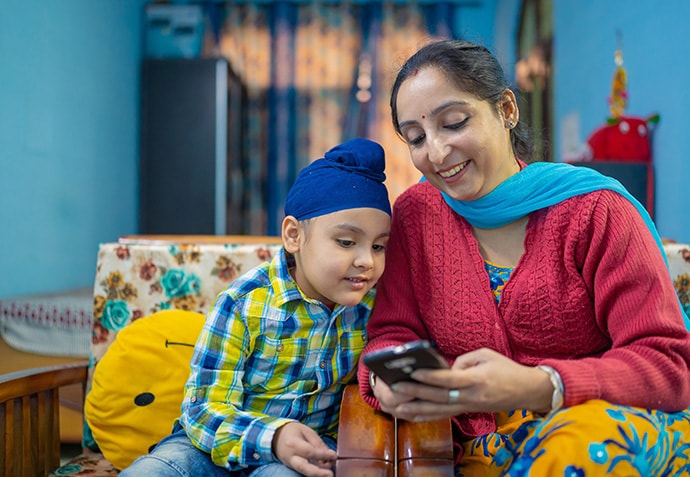
Worldreader eN-READ project in India – Worldreader empowers caregivers to support their child’s reading journey at home, school, and beyond. Photo: Worldreader
Think about your favorite book from your childhood – did you read it with your family before bedtime? Or maybe at your school’s book club?
For many children in the US and around the world, accessing inspiring and unforgettable stories isn’t easy. Time and resources aren’t enough to support the foundational reading they need to reach their potential. And too often, parents and caregivers lack confidence in their own reading skills to promote reading at home.
But the good news is, reading is changing. And technology is being used to bring world-changing stories to children and families everywhere.
In a 2020 by Worldreader, a non-profit organization that provides digital reading materials to under-resourced communities, 68% of respondents in Sub-Saharan Africa said they prefer to read on mobile phones. And a 2021 survey Save the Children found that 34% of parents in low and middle-income countries read stories to their children from a phone.
Reading can now take place almost anywhere.
“It can happen anytime – in a laundromat, or sitting on a bus when you’re taking your child to school,” says Rebecca Leege, Chief Impact Officer at Worldreader.
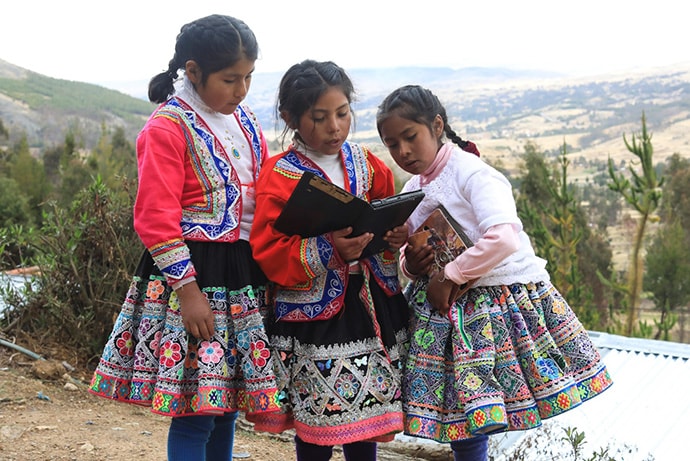
Since 2010, Worldreader has reached over 21 million readers in more than 100 countries. CreceLee project in Peru’s Cusco region. Photo: Worldreader
What and when people read also looks different across cultures, too.
“It may be on a Wednesday afternoon that we see more readership happening in some countries versus a Sunday afternoon, depending on what’s culturally relevant in those communities.”
In India, people read more for news and information while in Sweden, people read for fun and pleasure. In China, science fiction and fantasy are popular with kids, while in Brazil, it’s all about adventure stories.
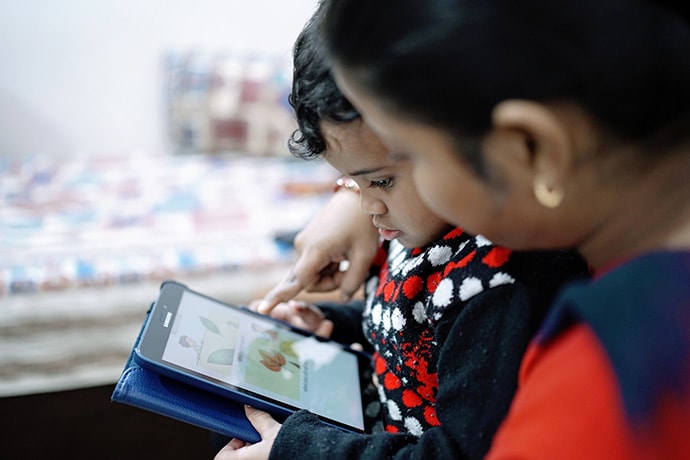
Worldreader India Read to Kids project – Since 2010, Worldreader has reached over 21 million readers in more than 100 countries. Photo: Worldreader
Founded in 2010, Worldreader is tapping into the data and cultural contexts of what people read and when, not to serve ads, but to improve reading rates and promote lifelong learning. The organization leverages digital technology and builds partnerships with schools, libraries, and community organizations to get children reading, increasing access to books, reading tools, and educational materials for families around the world.
An early-stage executive at Amazon, co-founder and Board President David Risher traveled the world with his family doing service-oriented work and volunteering, and saw the learning gap for himself in the form of empty school libraries and outdated books. He used his knowledge of Amazon’s Kindle to build BookSmart, a digital reading platform to motivate and engage families to read with and to their children anytime, anywhere.
Now, BookSmart is being used in more than 100 countries, delivering a reading experience based on over 3 thousand children’s titles in English, Spanish, Hindi, Arabic, and Kiswahili. Since 2010, Worldreader has reached over 21 million readers.
“We know that a child’s love of reading starts at home. If you don’t have opportunities to read from a young age, you’re never going to have enough reading practice. And you’re ultimately not going to become a reader,” says Leege. “We also know that caregivers want to give their children the best chance at a fulfilling life. So how can we promote a culture of family reading and provide caregivers with opportunities to support their children’s learning journey, anytime and anywhere they can?”
And it’s not a moment too soon. The learning crisis has been exacerbated by COVID-19, and UNICEF warns that 64% of ten-year-olds cannot read or understand a simple five or six-sentence story – meaning that they’re living in learning poverty.
According to “The State of the Global Education Crisis,” a joint study of UNESCO, UNICEF, and the World Bank, learning poverty increased from 50 to 70% for children in low and middle-income middle countries. Due to school closures, students now risk losing $17 trillion in lifetime earnings, or the equivalent of 14% of the global GDP.
“We’ve gone back two decades in the United States in terms of reading proficiency,” says Leege. “And I think we have to be really creative on how we integrate reading across community sectors for us to be able to make that next big leap forward in addressing these statistics.”
And by using new approaches to get technology into the hands of parents and children, as well as relying on a robust set of data-gathering practices to inform these approaches, Worldreader is doing just that.
For example, in the United States, Worldreader worked with a partner organization, Raising a Reader, to set up a BookSmart program at Ravenswood Family Health Center in California. Pediatricians, who now recommend up to 20 minutes of reading a day at minimum, can even reach families in the waiting room and continue to ensure their families read at home right with the mobile they own.
“Where else do we reach parents and where are they sitting with their children?” asks Leege. “Our data shows that families are reading several 100 pages a week of content in these communities, and these are some of the most vulnerable in that area.”
It’s proven so popular that Ravenswood has opened up a second BookSmart program site in Daly City.
Latin America is among the regions where learning poverty has increased the most during the pandemic, going from 52% to 79% in just two years. Worldreader’s CreceLee program takes a holistic approach, supporting mobile reading at home while working with educators to increase reading resources in the classroom.
Ericka Lock, Principal of the Kaphan Foundation and Worldreader US Board Member, says: “I have seen the power of Worldreader’s CreceLee program in Peru, when families, communities, and schools join hands in getting children reading. When children are read with and read to, you begin to see their own reading confidence grow, and their educational outcomes improve. Offering families BookSmart with great children’s books and activities right on the phone they already have, benefits not only the kids but the whole family and their community.”
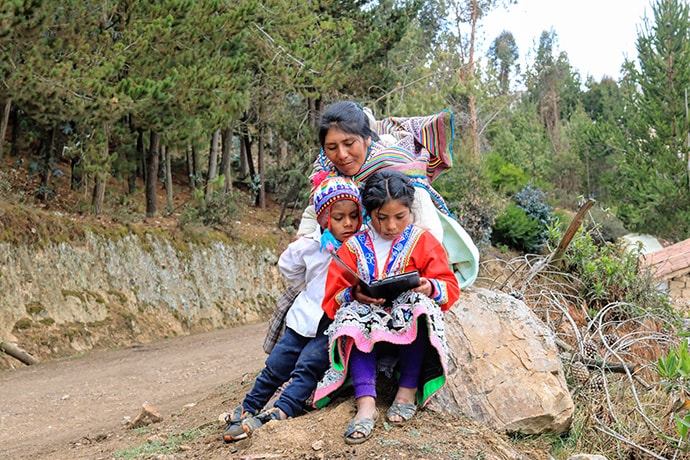
CreceLee project in Peru’s Cusco region. Photo: Worldreader
Reading, says Leege, can be a life-changing experience. That’s why BookSmart has built-in activities and upcoming gamification elements connected to the content in its library. Kids can feel proud of their reading accomplishments while parents can engage their children in simple, structured activities designed to support not only literacy skills but also help with social and emotional learning, being self-aware, and practicing empathy.
“A five-minute story can turn into a fifteen-minute beautiful discussion between a child and a caregiver,” says Leege.
These are small things, Leege says, but they have huge implications for that child’s education trajectory as they go forward.

Readers can access the BookSmart reading experience anytime, anywhere, on any device. Photo: Worldreader
“If you become a reader, you have a 30 to 40% increase in your earning potential compared to your illiterate counterparts. That’s significant.”
Also significant, and on a global scale, is the impact that reaching Sustainable Development Goal 4 – ensuring inclusive and equitable quality education for all – can have on the success of the other 16 Sustainable Development Goals.
Albert Zeufack, the World Bank’s former chief economist for the Africa region, said that “if we address the learning crisis, it will have the same effect as eliminating extreme monetary poverty, stunting, or hunger.” Meaning that empowering parents and caregivers to read with and to their children can help us build a better world for all.
And it all starts with a family, a story, and a mobile device.
Back to Top
Goalmaker
Q and A with Rachel Hartgen, Senior Director, Education and Adolescent Empowerment, Program Strategy & Impact, CARE
By Joel Meyers
 When thinking about Education and Gender Equality, we are reminded of the amazing history and current strides CARE is making in defeating poverty, saving lives, and achieving social justice across the globe. Since 1945, CARE has been helping marginalized peoples and communities, and in 2022 alone, CARE and partners worked in 111 countries implementing 1,600 poverty-fighting development and humanitarian aid projects and initiatives that reached 174,000,000 people. Crucial to these efforts is their Education & Work programs where they believe “Education and the right to work are the most powerful tools in overcoming extreme poverty.”
When thinking about Education and Gender Equality, we are reminded of the amazing history and current strides CARE is making in defeating poverty, saving lives, and achieving social justice across the globe. Since 1945, CARE has been helping marginalized peoples and communities, and in 2022 alone, CARE and partners worked in 111 countries implementing 1,600 poverty-fighting development and humanitarian aid projects and initiatives that reached 174,000,000 people. Crucial to these efforts is their Education & Work programs where they believe “Education and the right to work are the most powerful tools in overcoming extreme poverty.”
We were very fortunate to be able to connect with Rachel Hartgen, Senior Director, Education and Adolescent Empowerment, Program Strategy & Impact at CARE where her team supports their country offices and other CARE Member Partners in designing and implementing education and adolescent empowerment (EAE) programming. Rachel responded to our questions from her office in Denver, CO.
How long have you been with CARE?
Just over 3 years.
What roles have you held previously?
Before I came to CARE, I worked for a local nonprofit that partnered with youth and their families from low-income areas to support them in finishing high school and accessing career pathways, including college. Prior to that, I led two program components of an FCDO-funded project in Nepal working to improve financial inclusion and literacy for remote communities and supported other programs in Asia. I also worked on designing and implementing a project committed to skills development for Nepalis to ensure they had the right skills to get jobs and start businesses. I enjoyed that these programs heavily engaged the private sector. Prior to that, I worked for several non-profit and for-profit organizations committed to economic and social justice.
How did they lead you to becoming Senior Director, Education and Adolescent Empowerment for CARE?
My passion is ensuring that young people have the skills they need to succeed, whatever that looks like for them and whether that comes through formal education or other pathways. I’ve enjoyed working at the intersection of education and economic development, as education is central to economic justice. My previous positions have also focused on supporting girls, women, and other marginalized groups which is central to CARE’s mission. My previous positions have also given me strong experience in working with several types of actors including communities, the government, and private sector to replicate and sustain programming, which is what we aim to do at CARE.
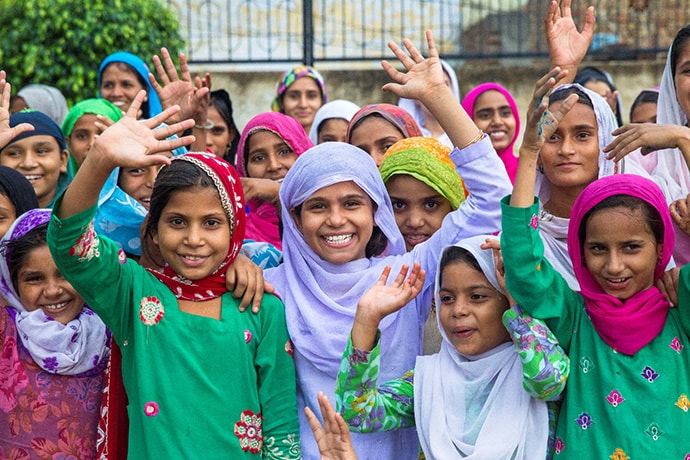
Photo: Erin Lubin, © CARE
What are your favorite accomplishments in this role at CARE?
It’s been a pleasure to revisit and update our Education and Adolescent Empowerment (EAE) Strategy with our team and other colleagues across CARE and partners in the sector to make sure we have models to achieve the impact we want to see. I’ve also enjoyed laying out how we are going to grow and sustain our SOAR model, discussed below, to support young people in getting a basic education. I’ve enjoyed growing our portfolio, particularly through designing new projects that strengthen the education system itself and those that use a holistic approach to meet the needs of children, adolescents, and youth. Finally, I’ve been proud of the exceptional team that we’ve built, even amid a global pandemic and working across multiple time zones.
What do you feel are the most pressing issues right now surrounding international education for marginalized children, especially girls?
Pressing issues continue to be that in many countries, more boys than girls are more likely to be in and graduate from secondary school and tertiary education. Fewer girls are getting to this level, largely due to early marriage, pregnancy, and social and gender norms that value their education less. Though, with the pandemic and its secondary effects, we’ve seen a rise in boys dropping out of school as well, often to work informal jobs to support their families. In terms of access, we continue to see that marginalized families continue to struggle to be able to send their kids to school and keep them there. Issues of climate change, civil war, and other crises are increasing household insecurity and forcing households to make difficult decisions on whether to not to send their children to school and if so, which children will attend. Another issue is the quality of education. We’ve seen a rise in the number of children who are unable to read and understand simple texts. They are neither learning basic knowledge nor softer skills required for the workforce. Finally, another pressing issue is that funding for education is remaining stagnant or decreasing in many countries. We need to encourage donors and governments to prioritize and fund education.
Tell us about the Strengthening Opportunities for Adolescent Resilience (SOAR) program…
The Supporting Opportunities for Adolescent Resilience (SOAR) program is one of CARE’s flagship programs. It provides accelerated education to out of school children, primarily girls. Many children still have never had the opportunity to go to school or have had to drop out. We saw this number increase with the effects of the pandemic. The longer young people are out of school, the less likely they are to return to school, particularly as they become too old for their grade level.
The SOAR program offers a condensed academic program in a short amount of time (usually 11 months) to help young people gain basic literacy and numeracy skills. It’s combined with leadership and life skills including leadership development, adolescent sexual and reproductive health, and digital and financial literacy skills. CARE’s and others’ research find that this holistic approach is key to keeping young people in school and helping them succeed. It also works with communities to help challenge and change social and gender norms that keep children out of school and to set up income generating activities and village savings and loan associations (VSLAs) to support the costs of education and other necessities. It also works with Ministries to help better track and support out of school children.
Graduates of the program can transition back into formal education at a grade appropriate for their age or transition to another pathway like a vocational training program or starting a business. In this way, young people gain skills that help them thrive. Over 4 million young people around the world have been reached through CARE’s SOAR program.

Of your other education programs, which are you excited about and why?
I’m excited about our systems strengthening work as it works in partnership with governments and other actors to strengthen the education system itself, at all levels, to provide a quality education to all children. This approach is more sustainable and resilient.
COVID, natural disasters, conflict, climate change – these all have created backsliding in the progress of childhood education. Why have these affected girls in particular?
These issues continue to affect girls and young women more because they amplify existing gender inequities. Girls and young women continue to have less access to resources and hold disproportionate responsibility for childcare and household chores including securing food, water, and fuel that keep them out of school or limit the time they can spend on their studies. When economic insecurity rises and there are entrenched social and gender norms, this continues to put more pressure on women and girls. In these cases, they are more likely to be pulled out of school, to marry early, to be subjected to gender-based violence (GBV), and become pregnant early. This is particularly true for more marginalized groups and those with intersecting identities including indigenous women, LGBTQI+ people, women and girls with disabilities, internally displaced and refugee women, etc., and those living in rural, remote, conflict and disaster-prone areas. In turn, this has multiplier effects that continue to limit their decision-making ability and resources.
What new CARE programs, policies and/or practices have helped mitigate these backslidings?
CARE has several programs, etc. that help mitigate this type of backsliding. It starts with challenging and changing social and gender norms around the value of education for girls and young women. Education is a human right. CARE does a lot of work in partnering with communities and powerholders to change these norms. CARE also does a lot of work in prevention and mitigation of gender-based violence and in removing barriers to education through scholarship programs, cash transfers, and more. Next, CARE is doing a lot in improving the quality of education and in remedial education to help ensure that children are learning while in the classroom and less likely to drop out. If they do drop out, CARE’s SOAR program and other skills development and economic resiliency programs can help support. Finally, through working with the government itself, CARE can strengthen the education system and social safety programs to help support children and families and keep them in school.
Are there new safeguards in place in your programs to make sure ground is not again lost if another pandemic, or other natural or man-made disaster, happens?
The biggest safeguard is working with governments and the education system itself to become more resilient so that if another pandemic, etc, happens again, that there are systems in place to help children to be able to continue to learn. This includes being flexible and making room for different types of learning, including remote and digital learning.
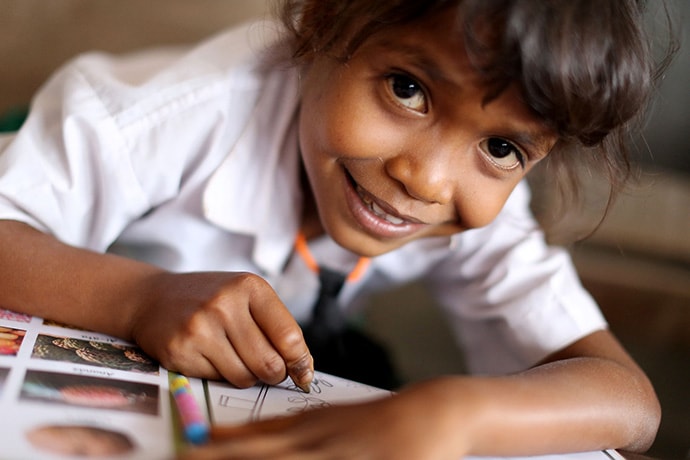
Photo: Josh Estey, © Josh Estey /CARE
When thinking about recent world events, what are you most concerned about?
I’m most concerned by the fact that we continue to have a youth bulge in several countries around the world. There are not enough good jobs for these youth and/or many young people don’t have the skills to get the jobs that do exist. We need to do a better job in helping ensure that young people can get and succeed in whatever a meaningful pathway looks like for them. Our education system needs to be more responsive and flexible for various learners and their needs throughout their lives.
What are you most hopeful about?
I’m excited to see the increased recognition and focus on the importance of early childhood education and development (ECE/D) by governments and other stakeholders. There is a recognition of the research that shows that we need to start early to see the gains that we want to see and to break cycles of multi-generational poverty. While we’ve still got a way to go, we’ve seen more governments and donors commit to funding and support for ECE/D.
Back to Top
Links for Issue Campaign: Education and Gender Equity (SDG4 & SDG5)
Blog Posts:
Pygmy Survival Alliance: Begin by Reading. End by Raising Women’s Status in Society
Sahar Education: Women and Girls’ Education: Courage and Resilience in the Face of Injustice
SE Asia Foundation: Education – The Key to Eliminating Poverty
Kati Collective: Health Education for Women and Girls Must Not Be at the Expense of Data Privacy, Security, and Rights
Violence-Prevention Education: An Essential Component to Ending Violence Against Women and Girls
Back to Top
Welcome New Members
Please welcome our newest Global Washington members. Take a moment to familiarize yourself with their work and consider opportunities for support and collaboration!
Worldreader
Worldreader is a global nonprofit whose mission is to help the world read through increased accessibility to digital books.
Worldreader.org
Back to Top
Member Events
May 25, 2023 Maximize Life Gala – The Max Foundation
June 24, 2023 World Refugee Day – Global Village Festival
Back to Top
Career Center
Vice President, Administration & Chief Financial Officer The Max Foundation
Director Global Supply Chain The Max Foundation
Senior Communications Manager SightLife / HCP Cureblindness
Chief Development Officer SightLife / HCP Cureblindness
Check out the GlobalWA Job Board for the latest openings.
Back to Top
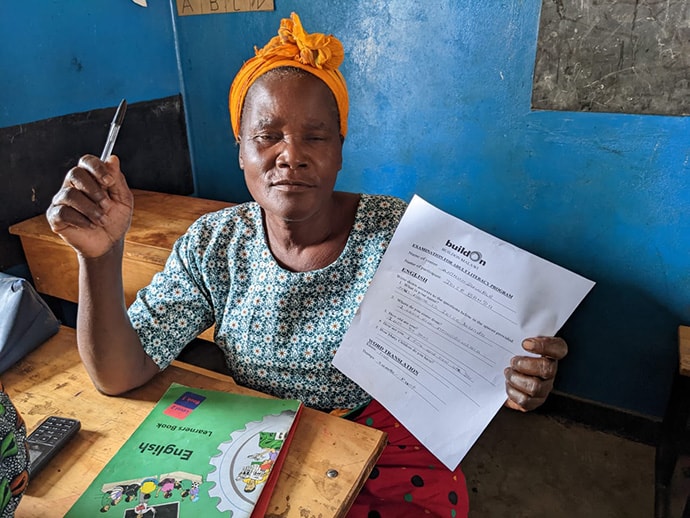
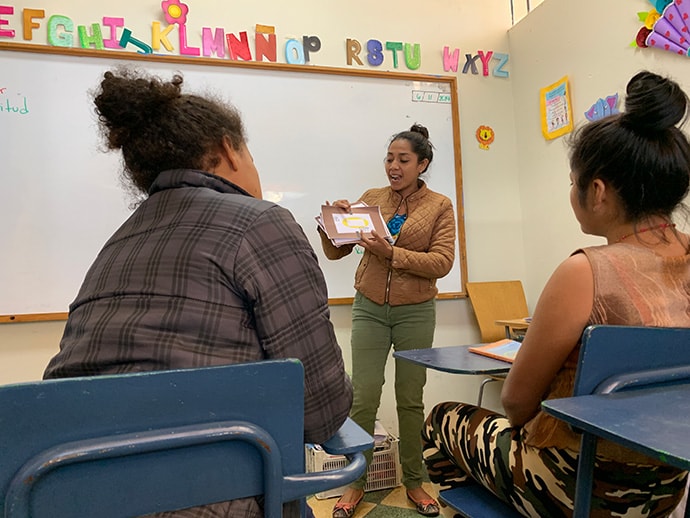
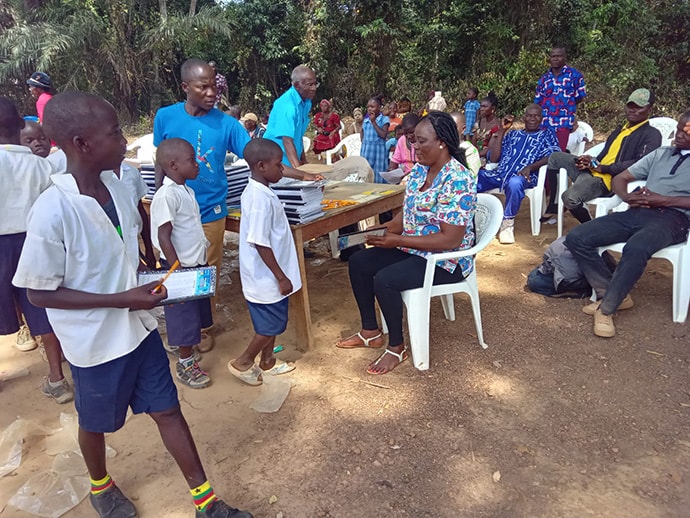













 When thinking about Education and Gender Equality, we are reminded of the amazing history and current strides CARE is making in defeating poverty, saving lives, and achieving social justice
When thinking about Education and Gender Equality, we are reminded of the amazing history and current strides CARE is making in defeating poverty, saving lives, and achieving social justice 


